Bazas, Gironde, Nouvelle-Aquitaine 作者: 来源: 发布时间:2021-04-07
I. Population and Area
Total Area: 37,29 km2 (14.39sq mi)
Population in 2017: 4 772
Population Density: 128/km2 (332/sq mi)
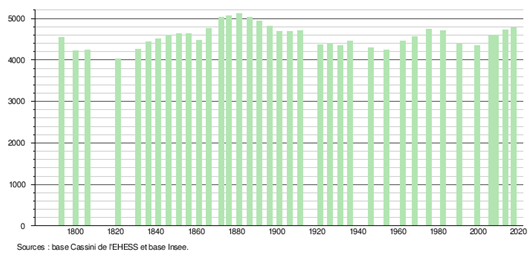
Histogram of demographic change
II. Natural Geography (environment and resources)
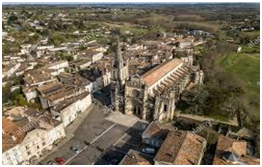
Bazas (Vasats in Occitan Gascon) is a commune in the South West of France, located in the Gironde department, in the Nouvelle-Aquitaine region.
The town of Bazas is located in the south-east of the department, on slight reliefs at the entrance to the Landes de Gascogne forest, 59 km south-east of Bordeaux, the capital of the department and 16 km to the south of Langon, chief town of the district.
The neighboring municipalities are Cazats to the north, Brouqueyran to the north-northeast, Lados and Gans to the northeast, Gajac to the east-northeast, Saint-Côme to the east, Sauviac to the southeast, Cudos to the south, Marimbault to the southwest, Lignan-de-Bazas to the west, Le Nizan to the northwest and Aubiac to the north-northwest.
Communication routes and transport:
The commune is crossed by the departmental road D 12 connecting Auros to the north and the national road 524 to the south and by the contiguous axis of the departmental roads D 3 and D 655, the first leading, towards the west, to Villandraut and au beyond the Arcachon basin, the second leading east to Grignols and Agen (Lot-et-Garonne).
Bazas is crossed by the A65 motorway. It is connected to it by the diffuser no 1, known as de Bazas, 3 km from the city center.
No railway line serves the town, the nearest SNCF station, 16 km away by road to the northeast, being that of Langon on the Bordeaux - Sète rail line from the TER Nouvelle-Aquitaine.
III. ECONOMY
Employment income (%): 71.4 (2016)
Poverty rate by age group of the tax advisor(%): 16 (2017)
Average employment income (€):2 234 net per month (26805 net per year)(2014)
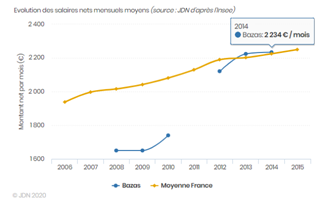
Evolution of average monthly net wages
Sources : http://www.journaldunet.com/business/salaire/bazas/ville-33036
https://insee.fr/fr/statistiques/2011101?geo=COM-33036#tableau-REV_G1
IV. Industrial Characterisitics
Cradle of the Bazadaise cattle breed. Polyculture and livestock, Landes forest in the south and west part of its territory:
On the economic and agricultural plan, the Bazadaise cattle breed contributes very largely to the fame of the city of Bazas. It is native to the hills of Bazadais and the Landes massif, where we trace its traces back to the Middle Ages. A former working breed, the Bazadaise is now a nursing breed specializing in the production of excellent quality meat. It is very present throughout the southwest of France. Its beefing and maternal qualities, its rusticity made the success of the breed abroad. It is exported to England, Australia, Belgium, Spain, Switzerland as well as South America and the United States.
Metal industry: RD Productions (gate manufacturing), Transtechnic, Sotomeca, Malambic.
Wood industry: isoplane door factory (Fonmartyetfils), teak furniture (Cobex).
Food industry: LDC Aquitaine (LDC group), Laurial, municipal slaughterhouse, NPA (cannery).
Various industries: paragel counters (Persohn SA).
Shops and crafts, banks, tourism.
Sources:http://www.ville-bazas.fr/votre-ville/
V. Attractions
1. L’ancienHôtel de ville et le musée municipal (The old town hall and the municipal museum)
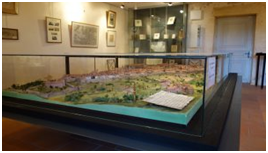
History of the building:
It is unclear at what time the town hall (or town house) was actually built on its current location at the back of the hall. What we do know is that Charles VII had it raised in 1498 at his expense. There are still some remains on the wall overlooking the Promenade de la Brèche where you can see old mullioned windows. The facade dates from the 17th century. In 1733, this one, very damaged, is restored. It was at this time that the building was struck in its triangular pediment of the city’s coat of arms. These represent the episcopal palace, the bishop being the lord of the city until the 13th century. On the left, the scene illustrates the takeoff of Saint-Jean-Baptiste. This work is the work of the sculptor Bacquey who will also add "three vases with flames and other ornaments" on the same frontispiece and engrave the inscription "Hôtel de Ville" above the door. After the French Revolution, the coat of arms will be completed with a chef sewn of azure loaded with three fleur-de-lis added in 1817 by Louis XVIII. They are crowned with a crown referring to the King-Duke of England and then to the King of France after the Hundred Years War.
The museum:
The municipal museum is located in the heart of the town, in the old City Hall. This building, built on the southern rampart of the city, overlooks the valley called the Brèche where flows, below, the Beuve. It is reached from the arcaded square by crossing the covered market built in 1890, replacing the first market which dates from 1485, by the architect Jean-Jacques Valleton.
Located on the ground floor of the old town hall, it occupies the 4 rooms of the old prison, covering an area of approximately 120 m2. The first room is largely occupied by a model representing the city around 1650. It was produced by four Bazadais between the years 1988 and 2002 according to the drawing of a Dutch traveler. In the other rooms, one can discover prehistoric and Gallo-Roman vestiges, those of a treasure from the Middle Ages, objects of sacred art, the original painting of "Saint Louis making alms" by Jacques Stella, as well as productions from the Zurbaran school.
From the first room, you can access, via a small stone staircase, a dungeon of around 11m2, also made of cut stone, whose state of conservation is remarkable. Its dating is from the XVIIth century. A very imposing wooden door, mounted on two wrought iron hinges, ensures the closing of the cell. It has a peephole, two locks and a huge overlay lock. Inside, the walls have been covered with several layers of whitewash on which we can guess inscriptions. In a corner of the dungeon is a seat of stone latrines. A narrow opening in the surrounding wall allows ventilation and lighting of the cell.
2. La Cathédrale – XIème-XVIIIème siècles (The Cathedral - 11th-18th centuries)
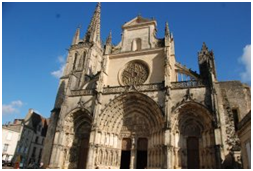
Listed as a historic monument in 1840 and listed as a UNESCO World Heritage Site in 1998 by the Way of Saint James in France, this majestic Gothic building is the most important in the city. The current cathedral was built from the 13th to the 14th century from a Romanesque construction whose traces are still visible in the base of the bell tower.
The two flying buttresses inserted around 1530 to reinforce it, the rosette with helical border and the neo-Greek crowning of the 18th century give the facade a unique aspect. The tympanum of the central portal is dedicated to the Last Judgment and to the life of Saint-Jean-Baptiste. The sculptures of the three external arches of the south portal, dedicated to the Virgin, develop an incomplete and damaged zodiac calendar as well as a rare Jesse tree. The north portal is dedicated to Saint-Pierre.
Inside, the perspective of the long, narrow nave, without the arm of a developed transept, produces an impression of serenity. Its vault is reflected in the holy water fonts. A plaque, located above the high altar, dedicated to Monsignor Arnaud de Pontac, bishop of Bazas, pays tribute to him for his help in the reconstruction of the monument after the Wars of Religion.
The cathedral's large organ, originally from Wenner, was completely restored in 1982-1983 by organ builder Robert Chauvin. The new organ includes 26 stops, or 1,796 pipes, 561 of which come from the Wenner organ, the wind tunnel of which was also recovered after having restored it. Robert Chauvin also designed a sideboard whose aesthetic recalls that of the 17th century with two large cantilevered side turrets. In a green color, the buffet seems to serve as a setting for the rosette now offered to everyone's admiration.
For the past three years, the cathedral has been the subject of extensive restoration work. A first phase, broken down into three sections, has just been completed. It was devoted to the restoration of the roof, the stained glass windows and the masonry of the nave. A second phase, which should be launched in spring 2017, will concern the restoration of the aisles of the North / South facades, the flying buttresses and tower. It will be carried out in four installments and will be the subject of requests for public aid.
3. L’Hôpital Saint-Antoine et son apothicairerie (Saint-Antoine Hospital and its apothecary)
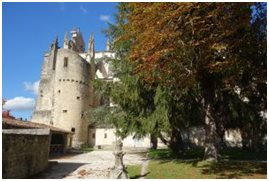
Located on the road to Saint Jacques de Compostelle via the Vézelay Way, Saint-Antoine hospital was built in the Middle Ages to accommodate pilgrims passing through. It was transformed into a care establishment in 1689 then put under the tutelage of the Daughters of Charity in 1698. Bazas being a bishopric, these are the three bishops who will succeed one another in Bazas until the Revolution who will take charge of the hospital. This is how it will grow in the 18th century and will have a chapel. This hospice served as a retirement home for the Bazadais until 2009. Today, it is practically abandoned. Only the renovated apothecary and a meeting room used regularly by the administration staff of the new hospital remain.
The Hospice, which includes a main body and a wing located at a northern angle, the Chapel and the Apothecary's office have been listed in the Additional Inventory of Historical Monuments since October 30, 2003.
Born from the will of a Superior of the Daughters of Charity, Marie Montié, the apothecary was installed from 1767. It has a Gironde tile floor and wood paneling tinted mahogany (the floor and paneling have This apothecary has an exceptional collection of pharmaceutical containers including 16th century ceramic albarelles, earthenware from Hustin and other factories in the South West, as well as pharmaceutical objects from the 19th century (medical equipment, pill box and sealing board). There are also earthenware from Lyon, Montpellier and Bordeaux.
It also has the distinction of having the largest collection of Bazadaise glassware from the 18th century. It is a production of local glassmakers, characterized by the blue-green produced by the reduction of iron in the presence of fern ash. These containers sometimes have strange shapes, the use of which is not always defined. It is also worth mentioning a collection of 6 fumigation pots, some with Chinese decor, including two from Montpellier (18th century).
It was with the Roman conquest that the people of the Vasates entered history. An episcopal city located on the Camino de Santiago de Compostela,Bazas was until the 18th century the seat of a diocese encompassing the towns of Langon, La Réole and Casteljaloux. Seat of a Presidium Bazas combines administrative and judicial functions and quickly establishes itself as the most powerful city in the region.
A two-thousand-year-old city, Bazas has managed to preserve superb vestiges, festivals and traditions and a unique know-how from its history.
4. La Place à arcades – XIIème-XIXème siècle (The Place with arcades - XIIth-XIXth century)
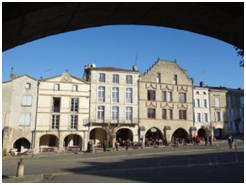
It is in itself a monument. The western part, a collapsed trapezoid of 4600 m2, linked to the merchant suburb of the Mercadilh, dates back to the end of the 12th century. The eastern part of 2800 m2, linked to the cathedral, is of recent development (XIXth century). The square has always kept its role of crossroads and market.
The "cutleries", or peripheral arches, were built from the 16th century. They are tuned to the types of houses they support. Its flowered areas are mainly embellished with open-air plantings facilitating the natural development of the rose and jasmine.
Among the many buildings bordering the square are some remarkable mansions such as the House of the Astronomer or Holland (16th century), the House of Andrault (17th century), the Bourriot Hotel (18th century) and the Presidial (18th century )
Sources :http://www.ville-bazas.fr/tourisme-et-patrimoine/histoire-et-patrimoine/
VI. History
From the first Iron Age, Bazas asserted itself as one of the strongholds of the Southwest by equipping itself with ramparts and monumental gates which very early on gave it a military role and a certain supremacy.
According to a poem by Paulin de Pella, in 414, the city escaped destruction by the Goths.
The ancient city is located east of the rocky plateau, around the cathedral. A second market town was formed in the central Middle Ages to the west of the old town. The junction of the two boroughs is achieved by the construction of a common enclosure in the 13th century, but the space separating the two sets remains not constructed, forming a gigantic central place ideal to serve as a market for this crossroads city, located at the crossroads roads of Bordeaux, Bayonne and La Réole.
An episcopal city located on the pilgrimage route to Santiago de Compostela, Bazas was, until the end of the 18th century, the seat of a diocese. Seat of the Presidential, Bazas combines administrative and judicial functions and quickly asserts itself as a major city. Its prestige has earned it visits from famous figures such as Richard the Lionheart and Charles V.
It was fiercely disputed between French and English troops during the Hundred Years War: it was besieged in 1347 by the English troops, and in 1370 by the French. It became definitively French again in 1441 when the city was taken.
Before his death, King Louis XI confirmed his royal protection by letters patent in February 1483.
1561 is a dark date in the history of Bazas, then affected by the wars of religion: the Huguenots entered the city and devastated the cathedral. The illustrious bishop Arnaud de Pontac saves the triple portal from total destruction and restores it.
In 1562, the Lord of Duras of the Huguenot party took the city: he cut the lips of the priests there.
Louis XIV stayed there on his return from Saint-Jean-de-Luz where he had married Marie-Thérèse of Austria.
Bazas has managed to preserve superb vestiges from this golden age. Listed as a historic monument in 1840, the Gothic cathedral is the most important monument in the city. Built from the 11th to the 14th centuries, it was rebuilt between 1583 and 1655.
Under the Old Regime, Bazas consisted of the parishes of Saint-Jean (cathedral), Saint-Vincent de Cabouzits and its annex Saint-Hippolyte, Saint-Martin and its annex Notre-Dame-de-Conques, Saint-Romain de Poussignac, Notre-Dame du Mercadil and its Saint-Romain de Tontoulon annex, Saint-Christophe de Guiron, Saint-Michel de Laprade and the Saint-Antoine chapel of the hospital.
It was chief town of district from 1790 to 1795.
Sub-prefecture until 1926, for the benefit of Langon, who also recovers the territory of the sub-prefecture of La Réole.
VII. Other information
Capital of Bazadais, former bishopric, it retains an important monumental ornament partially inherited from the Middle Ages and symbolized by the Saint-Jean-Baptiste cathedral.
VIII. Contact information
Bazas town hall address :
Bazas town hall
2 cathedral square
33430 Bazas
Opening Hours of the town hall:
Monday to Thursday: 8:30 a.m. to 12:00 p.m. and 1:30 p.m. to 5:30 p.m.
Saturday: from 9 a.m. to 12 p.m. (Reception opens only for civil registration.)
Friday: 8:30 a.m. to 12:00 p.m. and 1:30 p.m. to 4:30 p.m.
Mayor :Bernard Bosset (Mandate : 2014-2020)
Phone number: 05 56 65 06 65
Fax: 05 56 65 06 66
Mail: mairie@ville-bazas.fr
Website:http://www.ville-bazas.fr
Sources :http://www.cartesfrance.fr/carte-france-ville/33036_Bazas.html#mairie
